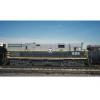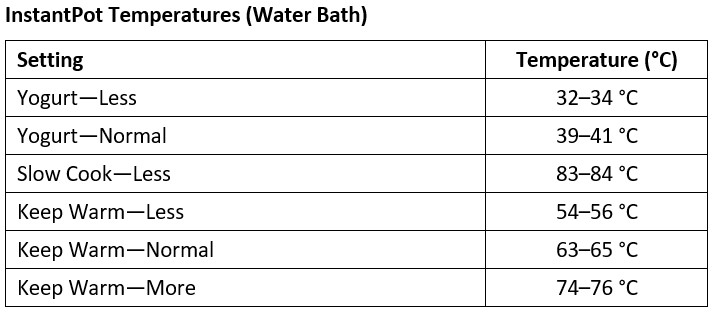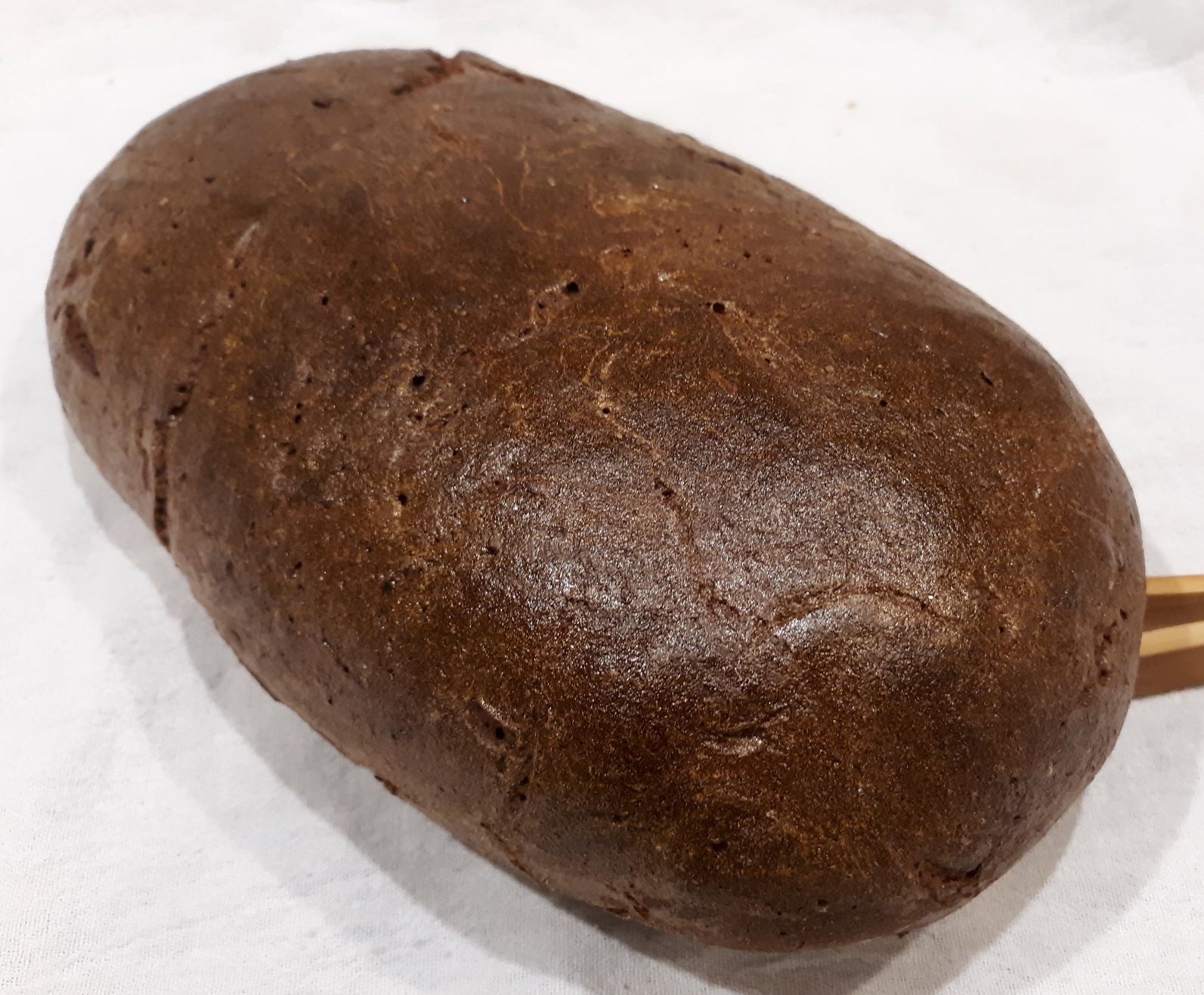
Latgaliešu Maize (Latgalian Rye, Latvia)—The Rye Baker

I finally screwed up enough courage to attempt the Latgalian Rye from Stanley Ginsberg’s website. It’s a more complicated recipe with several steps at elevated temperature. But @Econprof, @Martadella, and @squattercity have all made some beautiful looking breads.
I don’t have a Brod & Taylor proofing box, so I had to improvise using appliances that I do own. The specifications page for the InstantPot Duo showed some temperature ranges that might work for the elevated temperatures for the scald and sour-scald in the recipe. Not wanting any surprises during the recipe, I measured the temperature of a water bath at some of the settings of the IP:

The Keep Warm and Yogurt temperatures looked most promising.
I scaled down the recipe to 1200 g because I wasn’t sure how my Bosch Compact would handle the full dough. The first day is preparation of the scald and a stiff rye sour sponge. The sponge was mixed according to the recipe using whole rye flour (Breadtopia) and refreshed rye sour culture (aka Vaal).
The scald has pale rye malt (Canada Malt via NYBakers), whole rye flour, and ground caraway (Penzey’s). Hot water was added and these were mixed in the IP and set at Keep Warm-Normal. The mixture was to be held at 65 °C for 16–18 h, but after ≈45 min, the temperature was at 68 °C. Fearing overheating during the unattended overnight period, I set the IP to Yogurt-Normal. I think the thick nature of the scald caused the bottom to overheat. In the morning, I set the IP to Keep Warm-Less and that setting gave 53–55 °C for the remainder of the heating period.
At this point, I decided to deviate from Ginsberg’s instructions and follow the Latvian recipe as described by Sergey and @Martadella (Latgalian Rye). I felt that heating the sour-sponge at 55 °C would kill off most of the LAB and yeast. The Latvian instructions add the sour sponge to the scald at ≈50 °C and hold for 3 h without mixing and allowing the temperature to fall to 28–32 °C. The sponge is then mixed into the scald and held for another 3–4 h at 28–32 °C. I followed this method using the Yogurt-Less setting. I did find that the stiff sponge was difficult to incorporate into the thick scald, but I tried to smash it in as much as possible.
The next step adds yeast to the mixture to boost the leavening. I added SAF IDY, mixed well, and held overnight at ≈27 °C. The next morning, it was very bubbly and had pH 3.5. It also appeared to have hard particles as if the IDY had not dissolved. I will follow @Martadella’s method of pre-dissolving the IDY next time.
No changes were made in the final dough mixing and shaping. I used a sprayer to moisten the dough instead of brushing with water. Proofed for 46 min. Baked for 30 min at 250 °C and for 15 min at 200 °C; applied cornstarch glaze and baked for 3 min. It smelled wonderful while baking—sort of apple-malty(?).
The waiting before cutting is sooooo difficult…



Comments
This type of bread indeed requires good temperature control and can be tricky without appropriate equipment. Your result looks great though! Looking forward to seeing the crumb and hearing your tasting notes :)
Thanks, Ilya. I was fortunate that the IP has settings that closely match the required temperatures. But I think Ginsberg has incorrectly interpreted the Latvian instructions that only require the scald to be rigorously controlled at 63–65 °C, and for only a few hours instead of 12–16 h. Both Sergey's and Andrey's blogs describe the simpler method. Maybe Ginsberg was attempting to put his own spin on the recipe?
I usually wait a full 24 h before cutting a 100% rye. But it's very difficult to be patient.
Yeah no need to keep the scald for so long, with diastatic malt the reaction should be done within 2-3 hrs at the right temperature. Basically, whenever it becomes very sweet and liquidy, it's done.
Wow! That looks magnificent. I salute your improvisations on the temperatures of the various scalds. And I'm impressed by your desire and ability to wait.
Thanks for the feedback. We'll see if all the improvisations work out. I think Ginsberg has over-complicated the recipe with the temperatures and timings. I may make changes next time.
Cutting/tasting later today (full 24 h). Working as a synthetic chemist really taught me to be patient and not try to rush a good thing! 😀😋
A very nice looking rye loaf. Well done with all the improvisations as the look of the loaf from the outside looks terrific. Waiting for the crumb shots.
Cheers,
Gavin
Thanks Gavin.
The crumb and flavor are otherworldly. It's was well worth the effort!
Seeing all these wonderful rye breads you folks are putting out makes me wish I loved rye more than I do. This loaf looks really hearty and hopefully you love it considering the considerable effort involved in making it. Nice bake!
Benny
Benny, this rye's for you!
This may be the one rye that will amaze your taste buds! I think it is well worth a try.
I’m looking at the recipe on the rye baker website and see pale rye malt (diastatic) do you think that diastatic malt barley would work? Don’t we just need the amylase in the malt, does it matter what the source if is from? Perhaps the concentration of amylase is different between barley and rye?
I hope an amylase expert answers your question.
If you want pale rye malt, however, it's probably avalable at one of Toronto's home brewing supply stores.
Rob
Good point Rob, I’ll have to look at this formula a bit more seriously and decide on the pale rye malt, unless I can just use diastatic barley malt which would be convenient since I have that already.
Benny
I'm no amylase expert, but I believe you can just use whole rye flour, it will just take longer.
From what I understand of the Latvian recipe from the Russian blogs, 2–3 h with rye malt is sufficient for the scald. In other Baltic rye bread recipes on the blogs, the option is given for rye malt or flour, but 5–6 h at 65 °C is needed for the scald if using rye flour.
If you do consider making this, you might want to look at @Martadella's version and Sergey's blog that I linked above. In Ginsberg's version , the scald is unnecessarily long and the sponge-scald probably should not be held at 55 °C, but at 28–32 °C..
Says somewhere that you can use the diastatic barley malt. That’s what I use. (My most recent loaf didn’t turn out correctly but it worked fine in the past.)
Yes Benny, you can use barley malt! That's what I have too. In theory, barley malt is a bit stronger in activity and the result might be more liquidy, so you might need to use a little less water for the final dough. I've used it with no issues.
Thanks all three of you for your opinions on barley diastatic malt. That makes sense to me. The adjustments to Ginsberg’s recipe also sound good to me as well. I think I’ll give this bread a try in the very near future.
This bread will be a good test of the Ankarsrum Assistent since it is supposedly excellent for rye breads.
Benny
This rye bread is truly amazing. I'm not sure I can do it justice with words. The aroma alone is sweet and redolent of fruit. The crust is chewy but not tough and the crumb is moist and custard-y.
But the flavor!!!!
I don't know how it is possible to extract so much flavor from the rye (and a touch of caraway). It does not taste like any rye bread I have ever had. There is a fruitiness that is reminiscent of apple and malt. There is a wine/cider/beer character as well. It is sweet despite not adding much honey. The caraway is subtle and has been transformed into some other flavor altogether.
This is a 100% rye bread for those that do not like rye breads. A non-rye bread fan said this bread was delicious.
This bread is a gift from aliens from the planet Secale!
One rye to rule them all.
your crumb is fantastic!!!
and your description catches the essence of this bread and has me hankering to make it again!
Congrats. And welcome to the club.
Rob
You're right. I (almost) don't want to make any other rye bread but this one. Maybe it did come from Middle Earth via Gandalf and not Secale.
Latgalian Rye deserves a Community Bake to shed light on a fantastic bread. The club should not be so exclusive.
I’ll have to try it using your method. Agree that it doesn’t taste like any other bread (that I know of).
Thanks! Your encouragement (and Rob's) nudged me into making this fabulous bread.
Next time I make this, I will hold the scald for 3 h at 65 °C and the sour-scald at 28–32 °C, using the method described by @Martadella and Sergey. No reason to make it more difficult than it has to be.
That sounds amazing. I've made similar breads, but not this one. I'll have to try my hand at this after your description!
I do have a problem maintaining 63-65C though, no way to do that unfortunately in the new flat... Gas ovens are annoying in more ways than one, I used to just use an electric oven for this.
Hi,
I just did a 65c solod scald (see Beets and Bones, 3 hrs) in a small crockpot with temp controller and water bath.
Look for a used one!!
Sounds perfect! I don't have a crockpot or anything similar unfortunately :(
You should consider getting an Instant Pot. They are very useful kitchen tools and with these scalds and saccharification even more useful. I do use it quite often especially the pressure cooking settings. It doesn’t take up too much space and is often on sale at a discount.
Benny
I have been considering it! The rice cooker feature is very tempting. Kitchen space is very limited, but it sounds like it could be quite versatile... I've never used a pressure cooker in my life though, so don't really know how useful it is...
Happy upcoming New Year, Benny and everyone:)
One thing to know, the stainless steel standard pot, isn’t as good for cooking rice as a non stick dedicated pot like you’d get with a rice cooker. You can do it but the rice will really stick. Easy enough to buy their non stick pot to use in the Instant Pot, or just deal with the rice sticking to the pot.
I use the pressure cooker for all sorts of things, I make my own stock/broth, many bean dishes, home made miso, bbq ribs, stews etc. etc. Oh how could I forget, it’s great for doing soft or hard boiled eggs. I use that function most often, it is so precise and easy and fast for eggs.
Happy New Year Ilya, you’ll be in 2023 before those of us in NA.
Benny
Thanks a lot for the useful information! I'll certainly go back to this thread if I decide to get an instant pot at some point :)
I'm already in 2023! Spending my holidays in Greece one hour ahead of my usual time zone :)
A CrockPot with a controller was my fallback method. But I think the IP will work for the scald if I use it as a water bath instead of direct heat of the scald.
Happy baking and Happy New Year!
Yes I use the Instant Pot as a water bath for the scald, that works the best and keeps the temperature most stable.
Happy New Year
Benny
First, I want to say what a great bake (enhanced by your glowing description) this bread appears to be. That led me to Stanley's recipe, which I have printed and intend to migrate to my spreadsheet format for baking.
Now I have some questions (and anyone else who has these answers is encouraged to chime in too). If I do not have pale rye malt (or barley malt), can I use any old diastatic malt? Is it possible to use fermented red rye malt (solod), which I have plenty of? Or would solod wreck the flavor, and the malt needs to be diastatic?
Next, did you use a stand mixer for the final dough? My experience with Stanley and his rye recipes is that he achieves something with his stand mixer that I do not. My preference for doughs that are mainly rye is to mix by hand. Would mixing by hand for this dough be fine?
Beginning with a Lithuanian bread and the Borodinsky bread, I have gotten more and more into rye loaves in the past year. This certainly looks like one to try.
You need a diastatic malt, not fermented rye malt. Any diastatic malt should work, unless you have something very strange?.. What do you have?
You can mix any rye dough by hand, but some of them are a bit of a workout, and always a sticky mess!
My malt is from Hoosier Hill Farm is is called Premium Dry Malt (Diastatic) Powder on the label of the container. It is somewhat old (i.e., past the "best by" date by a few years). Is that likely to be a problem, or is diastatic malt something that lasts a long time?
As for kneading by hand, I have hand and arm strength and have mixed the dough for a Lithuanian bread and for the Borodinsky bread by hand. The stickiness I deal with by wearing a Nitrile glove, which works great with that type of dough, and I keep a bowl of water nearby along with a curved dough scraper.
Thanks for your reply.
I have the same diastatic malt Ted and it too is past the best before date. When I have used it, it seems to work just fine including when I saccharified various porridges.
Diastatic malt powder with no other description will be barley malt powder. That's the "standard" malt, most commonly used for both brewing and baking.
Good solutions, agree with all your ideas!
Thanks, Benny and Ilya, for your replies. Looks like sometime early in the new year I need to try this bread.
Happy baking.
Thank you for the compliment. The bread is well worth the effort.
You should be able to use any diastatic malt or you can just use rye flour, but it will take about twice as long (5–6 h instead of 2–3 h).
The fermented rye malt could be used in addition to the pale malt. It would not be completely authentic, but it has been done (you'll need a Russian translator):
https://registrr.livejournal.com/68788.html
I used a Bosch Compact mixer. Its dough hook is only moderately effective at mixing the dough. It requires a lot of scraping to push the dough back to the middle of the bowl.
See my response to Ilya for some info. I will not use any solod but only a diastatic malt. With Ginsberg recipes I don't see any benefit to using a stand mixer, and I end up using a bench scraper anyway.
This bread looks like one that is worth the extra effort.
With a scald (+ remaining liquid, 80% hydr overall) poured on the whole grain flour, the zojirushi was able to handle the dough mix-in 30 min the dough was smooth and well mixed. The motor might have been straining and so maybe 2/3 of the recipe (of 475g total whole grain) would be more appropriate.
PS I did have solod in the scald but it was not the recipe above.